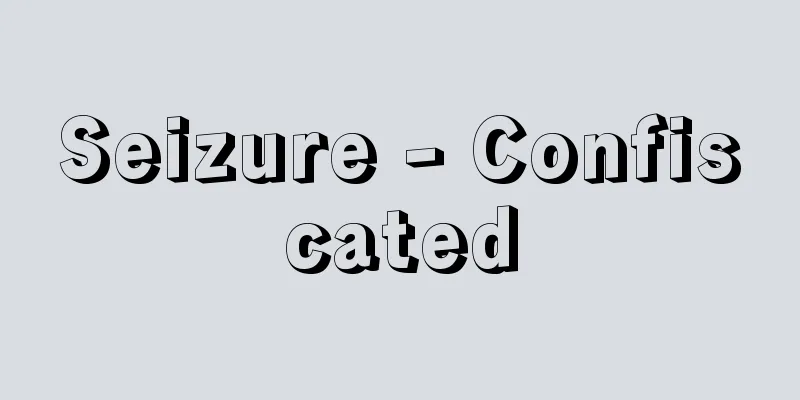Seizure - Confiscated

|
In a broader sense, it refers to an act of authority by a state institution to forcibly restrict specific objects or rights in preparation for a specific later purpose. Under the Civil Execution Act, it is used in a narrower sense, referring to the first step in monetary execution, whereby specific assets are secured under state control in preparation for liquidation or satisfaction by the enforcement agency. In other words, in monetary execution, in order to satisfy the creditor's claim, it is usually necessary to go through three steps of procedures: "seizure," "liquidation," and "satisfaction." In the first step, it refers to the enforcement agency's act of securing the debtor's specific assets, which are the subject of execution, in a state in which they can be liquidated, and in order to do so, the enforcement agency prohibits the debtor from disposing of the assets in effect (e.g., loss) or legally disposing of them (e.g., transfer) on his or her own accord. Under administrative law, it is one of the procedures for compulsory collection, and for example, as a procedure for collection of delinquent national taxes, collection officials must seize the assets of delinquent taxpayers in relation to their national taxes (Article 47 of the National Tax Collection Act). Under the Code of Criminal Procedure, judgments for fines, penalties, confiscation, collection of equivalent value, and non-penal fines are executed by order of a public prosecutor, and are carried out in accordance with the provisions of the Civil Execution Act and other laws and regulations related to compulsory execution procedures (Article 490 of the Code of Criminal Procedure). The same applies to the execution of judgments for non-penal fines under the Code of Civil Procedure (Article 189) and the Non-Contentious Cases Procedure Act (Article 121). [Takeyoshi Uchida and Tetsuo Kato, May 19, 2016] Civil enforcement seizureThe methods of attachment vary depending on the subject of execution. Immovable property can be attached by serving the debtor with a decision to commence compulsory auction (Civil Execution Law, Article 45) or a decision to commence compulsory administration (Civil Execution Law, Article 93) (Civil Execution Law, Articles 45, Paragraph 2 and 111). A ship can be attached by making a decision to commence compulsory auction and ordering the bailiff to take away the "ship's nationality certificate, etc." and submit it to the execution court (Civil Execution Law, Articles 114 and 121). Movable property can be attached by the bailiff taking possession of the object or by sealing it or indicating the attachment by other means (Civil Execution Law, Article 123), and claims and other property rights can be attached by serving the debtor and third debtor with a decision-based order of attachment issued by the execution court (Civil Execution Law, Articles 143, 145, 163 and 167). With a seizure, the debtor loses the right to dispose of the seized property or rights, and the state acquires them. This is the effect of prohibiting disposal, which is the core effect of a seizure. Therefore, for example, if a debtor sells the seized land to a third party, the sale is invalid to the creditor. However, since the seizure is necessary to liquidate the seized property, the effect of prohibiting disposal is limited to the extent necessary for liquidation, so if the seizure is lifted, the sale to a third party will be valid. When attaching movable property, excessive attachment beyond the extent necessary to satisfy the execution claim (Article 128 of the same law), useless attachment where the amount of the attached property even if converted into cash is not enough to cover the execution costs (Article 129 of the same law), and double attachment of the same property (Article 125 of the same law) are prohibited. Furthermore, from the perspective of protecting the debtor, there are certain properties that cannot be attached. For example, the items listed in Article 131 of the Civil Execution Law, such as the clothing, bedding, furniture, one month's food and fuel of the debtor and his/her relatives living with him/her, official seals, medals, and Buddhist statues, cannot be attached. In addition, as a general rule, the portion of claims such as salaries and wages equivalent to three-quarters of the payment cannot be attached (Articles 152 and 153 of the same law). [Takeyoshi Uchida and Tetsuo Kato, May 19, 2016] Seizure in criminal proceedingsSeizure is a measure to forcibly obtain possession of an object believed to be evidence or confiscated. The object is interpreted as a tangible object (the general view), and intangible objects such as conversations and information cannot be subject to seizure. Tangible objects such as buildings and body parts can be subject to seizure. The Constitution stipulates that the right of every person to be free from intrusion, search, and seizure of his or her home, papers, and belongings shall not be violated without a warrant issued for a valid reason and specifying the place to be searched and the items to be seized, except in cases involving lawful arrest (Constitution, Article 35, Paragraph 1). Furthermore, it stipulates that searches and seizures shall be carried out with separate warrants issued by competent judicial officials (judges) (Constitution, Article 35, Paragraph 2), establishing the principle of the so-called warrant system. Seizures may be carried out by investigative agencies or by courts. In principle, investigative agencies may seize property with a warrant issued by a judge when it is necessary for the investigation of a crime (Criminal Procedure Code, Article 218, Paragraph 1). The warrant must clearly indicate the property to be seized (Criminal Procedure Code, Article 218, Paragraph 1). In many cases, a warrant is issued together with a search warrant as a search and seizure permit. When executing a warrant, it must be shown to the person to whom it is to be dispositioned (Criminal Procedure Code, Article 110), and necessary measures such as removing locks and opening seals may be taken (Criminal Procedure Code, Article 111). In addition, when a property is seized, a list of the property to be seized must be prepared and given to the owner, etc. (Criminal Procedure Code, Article 120). However, as an exception to the warrant system, investigative agencies may seize property at the scene of arrest without a warrant when arresting a suspect, if necessary (Criminal Procedure Code, Article 220, Paragraphs 1, 3, and 4). Regarding the "significance of the case of arrest," case law has stated that it refers to the time of arrest, which is broader than the mere time of arrest, and that although a temporal connection with the arrest is required, the chronological relationship with the start of the arrest should not be considered. For example, if a police officer goes to the suspect's house to make an emergency arrest and the suspect happens to be absent, as long as a search and seizure are carried out under the condition that an emergency arrest will be made as soon as the suspect returns home, and the arrest is made in a timely manner, the search and seizure do not prevent the search and seizure from being considered to have been carried out at the scene of the emergency arrest. In addition, regarding the "significance of the scene of arrest," the police officer has stated that, for example, taking the arrested suspect to the nearest suitable place for seizure and then carrying out the search and seizure can be considered to be the same as a seizure at the scene of arrest. Next, when necessary, the court may seize evidence or items believed to be subject to confiscation (Article 99, Paragraph 1 of the same law). The court may also designate items to be seized and order the owner, possessor, or custodian to submit the items (Article 99, Paragraph 3 of the same law). This is known as an order to submit items, and is a disposition that is not permitted for investigative agencies. Furthermore, a warrant of seizure is required for seizure outside the courtroom (Article 106 of the same law). Regarding the method of seizure of electromagnetic records, the 2011 amendment to the Code of Criminal Procedure established new seizure procedures for electromagnetic records to deal with so-called high-tech crimes resulting from the sophistication of information processing by computers. Electromagnetic records often contain large amounts of data, and their seizure may result in the seizure of third-party data as well as cause disruption to the business of the person subject to the action, such as an Internet service provider. Therefore, first, a method of execution of seizure that collects only specific information when a seizure warrant for electromagnetic records has been issued was approved. In other words, when the thing to be seized is a recording medium related to electromagnetic records, instead of seizing it, (1) the electromagnetic records recorded on the recording medium to be seized may be copied, printed or transferred to another recording medium, and the recording medium may then be seized (Article 110-2, item 1 of the same law), or (2) the person to be seized may be made to copy, print or transfer the electromagnetic records recorded on the recording medium to be seized to another recording medium, and the other recording medium may then be seized (Article 110-2, item 2 of the same law). Copying here means copying an electromagnetic record to another recording medium, printing means printing out on paper, and transferring means copying an electromagnetic record to another recording medium, and then erasing the electromagnetic record from the original recording medium. Secondly, seizure with recording order allows the court to order the person who keeps the electromagnetic records or other person who has the authority to use the electromagnetic records to record or print the necessary electromagnetic records on a recording medium and then seize the said recording medium (Article 99-2, Article 218-1 of the same law). This is the creation of a new compulsory disposition, and is a form of disposition that is premised on the trust of the person against whom the disposition is made in the act of recording. [Soriichi Taguchi April 18, 2018] [References] | | | | | | | | |Source: Shogakukan Encyclopedia Nipponica About Encyclopedia Nipponica Information | Legend |
|
広義では、国家機関の権力的行為として、後になす一定の目的の準備のため、特定の物や権利を強制的に拘束することをいう。 民事執行法上では、これより狭義に用い、金銭執行の第一段階として、執行機関による換価ないし満足の準備をするべく、特定の財産を国家の支配下に確保することをいう。すなわち、金銭執行においては、債権者にその債権の満足をさせるためには、通常「差押え」「換価」「満足」の3段階にわたる手続を経ることが必要である。その第一段階として、執行の目的物である債務者の特定の財産を金銭化できる状態に置く執行機関の確保行為をさし、そのために執行機関は、債務者がかってにその財産を事実上処分したり(例、滅失)、法律上処分したり(例、譲渡)することを禁止する。 行政法上は強制徴収の手続の一つで、たとえば国税徴収などのための滞納処分として、徴収職員は滞納者の国税につき、その財産を差し押さえなければならない(国税徴収法47条)とされている。刑事訴訟法においても、罰金、科料、没収、追徴、過料などの裁判は、検察官の命令をもって執行し、その際には民事執行法その他強制執行の手続に関する法令の規定に従ってなされる(刑事訴訟法490条)。また民事訴訟法(189条)や非訟事件手続法(121条)における過料の裁判の執行についても同様である。 [内田武吉・加藤哲夫 2016年5月19日] 民事執行の差押え差押えは、執行の目的物が異なることによって、その方法も異なる。不動産の差押えは、執行裁判所の強制競売の開始決定(民事執行法45条)、または強制管理の開始決定(同法93条)を債務者に送達することによる(同法45条2項、111条)。船舶の差押えは、強制競売の開始決定をし、かつ執行官に対し、「船舶国籍証書等」を取り上げて執行裁判所に提出すべきことを命じなければならない(同法114条、121条)。動産の差押えは、執行官が目的物を占有するか、封印その他の方法で差押えの表示をして行い(同法123条)、債権その他の財産権の差押えは、執行裁判所が決定の形式でする差押え命令を債務者および第三債務者に送達して行われる(同法143条、145条、163条、167条)。 差押えにより、債務者は差し押さえられた物や権利を処分する権能を失い、国家がこれを取得することになる。これが差押えの効力の中心をなす処分禁止の効力である。したがって、たとえば債務者が差し押さえられた土地を第三者に売却した場合、その売買は債権者に対しては無効である。ただし差押えは、差押え財産の換価のために必要なのであるから、その効果としての処分の禁止も換価のために必要な限度に限られるので、差押えが解除されれば、第三者への売却は有効なものとなる。 動産の差押えに際しては、執行債権の満足に必要な範囲を超える超過差押え(同法128条)、差押え財産を換価しても執行費用にも足りないような無益な差押え(同法129条)、同一物についての二重差押え(同法125条)は禁止される。さらに債務者保護の見地から差押え禁止財産が法定されており、たとえば、債務者およびその同居の親族の衣服、寝具、家具、1月間の食料および燃料、実印、勲章、仏像など、民事執行法第131条に列挙された物は差し押さえることができない。また、給料・賃金などの債権は、原則として、その給付の4分の3に相当する部分は、差し押さえてはならない(同法152条、153条)とされている。 [内田武吉・加藤哲夫 2016年5月19日] 刑事手続における差押え差押えとは、証拠物または没収物と思われる物の占有を強制的に取得する処分をいう。その対象は有体物と解され(通説)、会話、情報などの無体物は差押えの対象となりえない。有体物であれば建造物でも身体の一部でも対象となりうる。憲法は、何人(なんぴと)も、その住居、書類および所持品について、侵入、捜索および押収を受けることのない権利は、適法な逮捕に伴う場合を除いては、正当な理由に基づいて発せられ、かつ捜索する場所および押収する物を明示する令状がなければ、侵されないと規定している(憲法35条1項)。さらに、捜索または押収は、権限を有する司法官憲(裁判官)が発する各別の令状により、これを行うと規定し(同法35条2項)、いわゆる令状主義の原則を定めている。差押えは、捜査機関が行う場合と裁判所が行う場合とがある。 捜査機関は、犯罪の捜査に必要な場合、原則として裁判官の発する差押状により差押えをすることができる(刑事訴訟法218条1項)。差押状には、差し押さえるべき物の明示が必要である(同法218条1項)。差押状は、捜索状と一括して捜索差押許可状として発付される場合が多い。差押状の執行にあたっては、処分を受ける者にこれを示さなければならず(同法110条)、錠をはずし、封を開くなどの必要な処分をすることができる(同法111条)。また、差押えをした場合には押収目録を作成して、所有者等に交付しなければならない(同法120条)。これに対し、令状主義の例外として、捜査機関は、被疑者を逮捕する場合において、必要があるときは、令状なくして、逮捕の現場で差押えを行うことができる(同法220条1項・3項・4項)。ここにいう「逮捕する場合の意義」について判例は、単なる逮捕の時点よりも幅のある逮捕する際をいうのであり、逮捕との時間的接着を必要とするけれども、逮捕着手時の前後関係はこれを問わないものと解すべきであるとしている。たとえば、緊急逮捕のため被疑者方に赴いたところ、被疑者がたまたま他出不在であっても、帰宅次第緊急逮捕する態勢の下に捜索、差押えがなされ、これと時間的に接着して逮捕がなされる限り、その捜索、差押えは、なお、緊急逮捕する場合その現場でなされたとするのを妨げるものではないとしている。また、「逮捕の現場の意義」については、たとえば、逮捕した被疑者を差押えに適した最寄りの場所まで連行したうえで実施することも、逮捕の現場における差押えと同視することができるとしている。 次に、裁判所は、必要があるときは、証拠物または没収すべき物と思われるものを差し押さえることができる(同法99条1項)。また、裁判所は、差し押さえるべき物を指定し、所有者、所持者または保管者にその物の提出を命ずることができる(同法99条3項)。いわゆる提出命令であり、捜査機関には認められていない処分である。なお、公判廷外における差押えには、差押状を必要とする(同法106条)。 電磁的記録物の差押えの方法については、2011年(平成23)の刑事訴訟法改正により、コンピュータによる情報処理の高度化に伴ういわゆるハイテク犯罪に対処するための電磁的記録物に関する新たな差押え手続が創設された。電磁的記録物には大量のデータが記録されている場合が多く、その差押えによって第三者のデータも差し押さえられる可能性があるとともに、プロバイダー等の被処分者の事業に支障を生ずるおそれもある。そこで、第一に、電磁的記録物に対する差押状が発付されている場合に、特定の情報のみを収集するという差押えの執行方法が認められた。すなわち、差し押さえるべき物が電磁的記録に係る記録媒体であるときは、その差押えにかえて、(1)差し押さえるべき記録媒体に記録された電磁的記録を他の記録媒体に複写し、印刷し、または移転したうえ、当該記録媒体を差し押さえること(同法110条の2第1号)、もしくは、(2)差押えを受ける者に差し押さえるべき記録媒体に記録された電磁的記録を他の記録媒体に複写させ、印刷させ、または移転させたうえ、当該他の記録媒体を差し押さえること(同法110条の2第2号)、ができる。ここにいう複写とは、電磁的記録を他の記録媒体にコピーすることをいい、印刷とは紙媒体にプリントアウトすることをいい、移転とは電磁的記録を他の記録媒体に複写したうえ、元の記録媒体から電磁的記録を消去することをいう。第二に、記録命令付差押えは、電磁的記録を保管する者その他電磁的記録を利用する権限を有する者に命じて必要な電磁的記録を記録媒体に記録させ、または印刷させたうえ、当該記録媒体を差し押さえることができるとするものである(同法99条の2、218条1項)。これは新たな強制処分の創設であり、被処分者の記録行為への信頼を前提とした処分形態である。 [田口守一 2018年4月18日] [参照項目] | | | | | | | | |出典 小学館 日本大百科全書(ニッポニカ)日本大百科全書(ニッポニカ)について 情報 | 凡例 |
>>: Sheath-tailed bat (English spelling)
Recommend
Inside and Outside
…His poetry is characterized by religious and oth...
Arnold, K.
…Usually translated as “unidentified flying objec...
Davies, D.
…A painter from the period of the Pre-Raphaelite ...
From behind
For example, the female doll "kurizu" i...
Al-Jāḥiẓ, Abū `Uthmān `Amr ibn Baḥr al-Kinānī
[Born] 776, Basra Died in 868/869. A Basra Arab wr...
Smirke, Sir Robert
Born: October 1, 1781, London [Died] April 18, 186...
Spider monkey - Kumozaru (English spelling)
A general term for animals in the genus Ateles, f...
Nuclear powered satellite
These are nuclear reactor satellites equipped with...
Wooden wife - Kinyobo
...In many places, women who were childless after...
Valladolid - Valladolid (English spelling)
The capital of Valladolid Province, Castilla y Le...
Kyonohimo (English name) Grateloupia okamurai
A seaweed in the family Centipediaceae of the orde...
Ekashi Ikiri - Ekashi Ikiri
In other words, men belong to the lineage of thei...
Bobinae
…A domestic cattle (bovine) kept around the world...
Amateur photos - amateur photos
However, among the techniques seen in early artis...
Recreational leisure - Kibarashireja
… [Classification of the leisure industry] In Tow...









